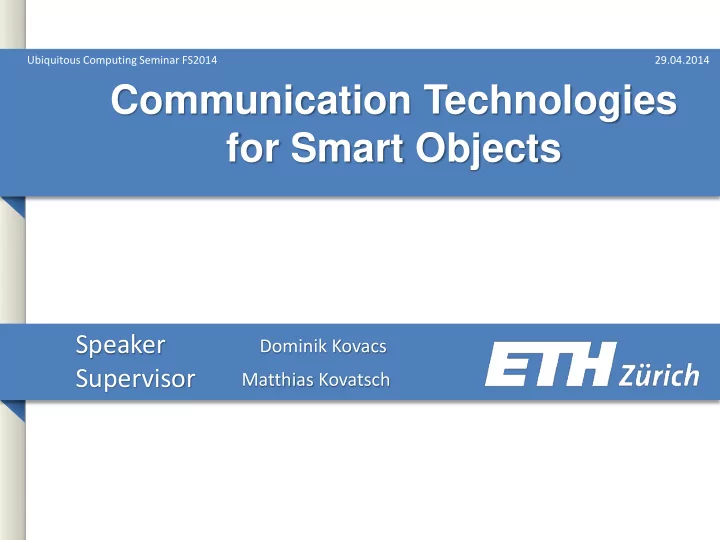

Ubiquitous Computing Seminar FS2014 29.04.2014 Communication Technologies for Smart Objects Speaker Dominik Kovacs Supervisor Matthias Kovatsch
An Internet of Things ” In the next century, planet earth will don an electronic skin. It will use the Internet as a scaffold to support and transmit its sensations.” – Neil Gross 1999 2
3
Check on the Baby http://mimobaby.com/ 4
Monitor an Aging Family Member http://beclose.com 5
Track your Activity Levels http://medgadgets.co 6
Smart Heating http://www.nest.com/ 7
Wireless Plant Monitoring http://www.fliwer.com 8
Smart Trash Can http://www.entertainmentearth.com 9
Smart Trash Can http://bigbellysolar.com/ 10
Smart Street Lighting http://www.designboom.com 11
Structure Monitoring http://smart-structures-inc.us 12
Floating Sensor Network 13
IoT components • Smart objects Smart object Smart object Smart object (sensor only) (actuator only) (sensor & actuator) – sensors, actuators – Little bit of processing • Communication network – Directional or bidirectional • Aggregator Aggregator – Collects data – Processes data – Publishes data 14
Motivation There are a huge variety of devices and use cases, but no technology fits them all… 15
Outline • Types of Communication – M2M & H2H • Introduction into Wireless Technology • Application Domains – Body Area Network – Smart Home – Smart Factory – Smart Grid & Logistics 16
M2M Definition • Relationship between two machines • No human interaction involved • Triggered by events (e.g. sensor events) 17
Iot vs M2M Internet of Things (IoT) Machine-to-Machine (M2M) • Vision of the Internet of • Communication between tomorrow machines • Requires M2M connectivity M2M as the connectivity of IoT Internet of Things M2M 18
M2M or not? Some intuition 19
M2M or not? Some intuition 20
M2M or not? Some intuition 21
M2M or not? Some intuition 22
M2M or not? Some intuition 23
M2M or not? Some intuition 24
Trivia: Identify Friend or Foe (IFF) US Army Air Defense Digest, 1972 25
Focus on Wireless M2M 26
OSI Model Wireless device implements 27
Wireless Network Difficulties 28
Radio Wave Spectrum A Limited Resource 29
Trivia: Bandwidth Allocation • In the US, the Federal Communications Commission (FCC) allocates bandwidth – Hearings (before 1982) – Lotteries (1980s) – Auctions (since the 1990s) 30
International Telecommunication Union (ITU) Region Region 1 Region 2 Region 3 wikimedia.org 31
Industrial, scientific and medical (ISM) radio bands Frequency range Availability ⁞ 13.553 MHz 13.567 MHz Worldwide 26.957 MHz 27.283 MHz Worldwide 40.660 MHz 40.700 MHz Worldwide 433.050 MHz 434.790 MHz Region 1 only 902.000 MHz 928.000 MHz Region 2 only 2.400 GHz 2.500 GHz Worldwide 5.725 GHz 5.875 GHz Worldwide ⁞ http://www.itu.int 32
Wireless Technologies (19) 33
Datarate-Range Comparison 34
35
Body Area Network (BAN) 36
Wearables and Implants Smart Glasses Sensor in clothes Smart Skin Smart Pacemaker Smart Watches Pedometers 37
BAN Characteristics • Low CPU power – Collecting rather than processing • Battery operated – Mobile • Small size → Small battery → Low power • No line of sight (body, clothes) • Can be health critical 38
BAN Communication Requirements • Power efficient • Robust against interference – Off-body – On-body • Interoperable Off-body interference 39
BAN Wireless Technologies 40
BAN Communication Requirements • Power efficient • Robust against interference – Off-body – On-body • Interoperable 41
BAN Wireless Technologies (7) Ultra Wideband ANT Bluetooth/BLE (UWB) Sensium IEEE 802.15.4 RuBee Zarlink 42
BAN Wireless Technologies (7) Ultra Wideband ANT Bluetooth/BLE (UWB) Sensium IEEE 802.15.4 RuBee Zarlink 43
Smart Home more than just «Home Automation» • Smart Heating • Smart Lighting • Smart Outlets • Smart Kitchen • Smart Gardening 44
Smart Home Characteristics • Stationary – But mostly battery operated though • Low cost – Huge Quantity • (Scalability) • No line of sight (walls) • Variety of different applications 45
Smart Home Communication Requirements • Sufficient range • Variable Bandwidth • Interoperable 46
Smart Home Wireless Technologies 47
Smart Home Communication Requirements • Sufficient range • Variable Bandwidth • Interoperable 48
Smart Home Communication Requirements • Sufficient range • Variable Bandwidth • Interoperable Proprietary Range too small Range too small 49
Smart Home Wireless Technologies (6) Wi-Fi RuBee RFID IEEE 802.11n IEEE 802.15.4 Insteon DECT ULE 50
Smart Home Wireless Technologies (6) Wi-Fi RuBee RFID IEEE 802.11n IEEE 802.15.4 Insteon DECT ULE 51
Smart Factory (Industry 4.0) 52
Smart Factory Characteristics • Bigger buildings – Wider coverage • Thicker and/or more walls (metals) • No line of sight • More money to spend 53
Smart Factory Communication Requirements • Long range or mesh topology support • Convergence of different subnetworks 54
Smart Factory Wireless Technologies 55
Smart Factory Wireless Technologies 56
Big range vs Mesh topology Big range Mesh topology • IEEE 802.11n: 100m • Z-wave: 300m • Wireless M-Bus: 1000m • IEEE802.15.4: 250m • DECT ULE: 300m • DASH7: 2000m • RFID: 100m 57
Big range vs Mesh topology Big range Mesh topology • IEEE 802.11n: 100m • Z-wave: 300m «Vendor-locking» Operates at 2.4 GHz • Wireless M-Bus: 1000m • IEEE802.15.4: 250m Operates at 868 MHz • DECT ULE: 300m Operates at 1.9 GHz • DASH7: 2000m Operates at 433.92 MHz • RFID: 100m Access control, Identification 58
Smart Grid http://www.hitachi.com 59
Logistics • Some specific applications – Quality of Shipment Conditions – Item Location – Storage Incompatibility Detection – Fleet Tracking http://www.tetra-logistics.com 60
Smart Grid & Logistics Characteristics Smart Grid Logistics • Centralized two-way • Mobile → battery powered communication (tree) • «Off-the-grid» • Wide coverage environments • Hourly peaks • Huge Variety 61
Smart Grid & Logistics Communication Requirements Smart Grid Logistics • Long range • Long range • Short transfer latency • Scalable (within a few ms) • Interoperable • Scalable • Interoperable 62
Smart Grid & Logistics Wireless Technologies 63
Smart Grid & Logistics Wireless Technologies 64
Smart Grid & Logistics Wireless Technologies SMS Data packets Indoor Environments Neighborhood Aggregator Low reception Environments Indoor Environments Neighborhood Aggregator 65
Weightless http://www.weightless.org 66
White Space Spectrum http://thinkd2c.wordpress.com/ 67
Conclusion 68
Recommend
More recommend